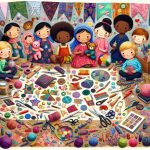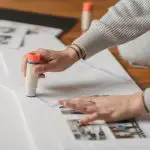When you start creating unique designs with fabric glue, you'll quickly discover how versatile this tool can be. You can choose fabrics that complement each other, cut them into various shapes, and layer them in innovative ways. By applying a thin, even layer of glue, you ensure a clean finish and a strong bond. However, there are techniques and tips that can elevate your projects from ordinary to extraordinary. You might be surprised at what you can achieve when you experiment—let's explore some creative project ideas that could inspire your next masterpiece.
Table of Contents
Key Takeaways
- Experiment with different fabric scraps to add color and texture to your designs for a unique touch.
- Use fabric glue to layer materials, creating depth in your projects like collages or embellished items.
- Incorporate embellishments such as beads or lace to enhance visual interest and personalize your designs.
- Test various fabric combinations on a small scale before committing to larger projects for optimal results.
Choosing the Right Fabric Glue
When choosing fabric glue, consider the specific materials and project requirements to ensure a strong bond. Different types of fabric glue cater to various needs, so it's essential to select the right one for your project.
For example, if you're working with delicate fabrics like silk or lace, opt for a water-based adhesive that dries clear and won't damage the material.
If your project involves heavier fabrics, like denim or canvas, a stronger, more industrial glue will provide the durability you need. Look for options labeled as permanent or heavy-duty; these are designed to withstand wear and tear.
Also, think about the drying time. Some glues set quickly, while others may require hours to cure completely. If you're in a hurry, a fast-drying glue can save you time, but ensure it provides enough time for adjustments before it sets.
Lastly, consider the flexibility of the glue once it dries. If your project requires movement, such as clothing or accessories, choose a flexible adhesive that allows for some stretch.
With these factors in mind, you'll find the perfect fabric glue for your unique design.
Preparing Your Materials
To create stunning designs, gather and organize all your materials before diving into the project.
Start by selecting your fabric; consider colors, textures, and patterns that complement your design. Once you've chosen your fabric, cut it to your desired shapes and sizes. It's crucial to ensure clean, straight edges for a polished look.
Next, collect your tools. You'll need fabric glue, scissors, and a measuring tape. If you're using embellishments like beads or rhinestones, have them on hand as well. Organizing everything in a workstation will help streamline your process and keep distractions to a minimum.
Don't forget to prepare your workspace. Lay down a protective covering to avoid any glue spills on your surface. Make sure you have adequate lighting to see your project clearly and avoid mistakes.
Techniques for Application
Applying fabric glue effectively requires a steady hand and a few key techniques to ensure your designs hold up beautifully.
First, always work on a clean, flat surface to prevent any accidents. Use a fine-tip applicator for precise control, especially when you're working on intricate designs. This helps you apply the glue exactly where you want it without creating a mess.
Next, don't overload the fabric with glue. A thin, even layer is often enough to hold your materials together and reduces the chance of seepage. If you're layering fabrics, apply glue to the top piece and press it firmly onto the base layer. Remember to leave some time for the glue to set before moving on to the next step.
For larger projects, consider using clamps or weights to hold everything in place while the glue dries. This ensures a strong bond and helps maintain the shape of your design.
Lastly, always test your glue on a scrap piece of fabric first. This way, you can see how it reacts and ensure it dries clear and strong.
With these techniques, you'll achieve stunning results with your fabric glue projects!
Creative Project Ideas
Unleash your creativity with fabric glue by transforming everyday items into personalized masterpieces, like custom tote bags or unique wall art.
One exciting project is to embellish a plain canvas tote with colorful fabric scraps. Cut shapes or patterns from the fabric, and use fabric glue to attach them. This not only gives your bag a fresh look but also makes it one-of-a-kind.
Another idea is to create a fabric-covered bulletin board. Use an old corkboard, cover it with your favorite fabric, and secure it with glue. Add decorative elements like buttons, ribbons, or patches to make it truly special.
You can also design custom coasters by gluing fabric onto cork or wooden bases. Choose vibrant patterns that match your decor, and seal them with a protective coating for durability.
If you're feeling adventurous, try making a fabric collage on a canvas. Layer different fabrics, glue them down, and add embellishments like beads or sequins. This art piece will brighten up any room.
With fabric glue, the possibilities are endless—get started on your next creative project today!
Tips for Successful Bonding
Ensuring proper bonding is crucial, so always clean the surfaces you plan to glue to achieve the best results. Dust, dirt, and oils can hinder adhesion, so wipe everything down with a damp cloth before starting.
Next, test your fabric glue on a small, inconspicuous area first. This helps you see how it reacts with your materials and ensures the color and texture remain unchanged.
When applying the glue, use a thin, even layer. Too much glue can cause a mess and weaken the bond. Press the fabric pieces together firmly, and don't forget to follow the manufacturer's drying instructions. Some glues require clamping or weight to ensure a strong bond, so consider placing a heavy book on top during the drying process.
Be mindful of temperature and humidity, as they can affect the glue's performance. Work in a well-ventilated area to avoid any unpleasant fumes.
Lastly, allow ample time for the glue to fully cure before using or washing your project. Following these tips will help ensure a successful bonding experience and lead to beautiful, durable designs.
Happy crafting!
Frequently Asked Questions
Can Fabric Glue Be Used on Non-Fabric Materials?
You might find that fabric glue can work on some non-fabric materials, like paper or certain plastics. However, it's essential to test a small area first, ensuring a secure bond and avoiding potential damage.
How Do I Remove Fabric Glue if I Make a Mistake?
To remove fabric glue after a mistake, you can gently scrape it off with a knife or use rubbing alcohol on a cotton ball. Always test a small area first to avoid damaging your material.
Is Fabric Glue Washable After It Dries?
Yes, fabric glue is generally washable after it dries, but its durability can depend on the specific brand and fabric. Always check the manufacturer's instructions to ensure the best results for your project.
What Are the Safety Precautions When Using Fabric Glue?
When using fabric glue, you should always work in a well-ventilated area, wear gloves to protect your skin, and avoid contact with your eyes. Make sure to read the label for specific safety instructions.
Can Fabric Glue Be Used for Outdoor Projects?
Yes, you can use fabric glue for outdoor projects, but make sure it's waterproof and UV-resistant. These features help ensure your designs withstand the elements and maintain their integrity over time. Always check the label!
- Tetron Fabric for Marine Applications: Durability and Use Cases - June 18, 2025
- Tetron Fabric for Outdoor Furniture: Weather Resistance and Care - June 18, 2025
- Tetron Fabric for Wall Coverings: Style and Application Tips - June 18, 2025







